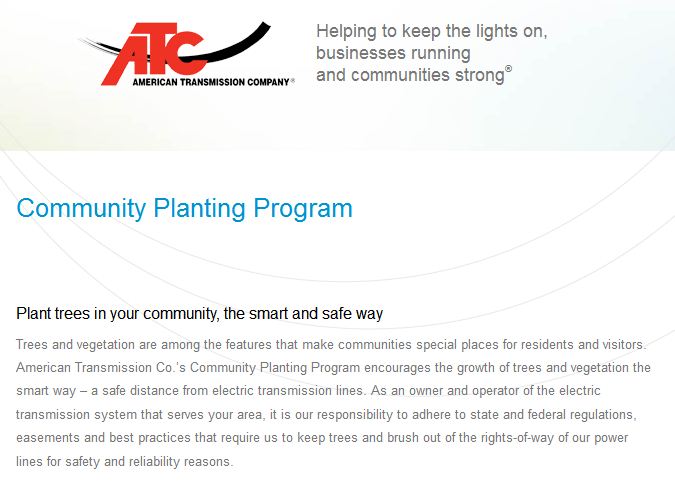ATC is a privately owned company. Utilities, municipalities, municipal electric companies and electric cooperatives from Wisconsin, Michigan, Minnesota and Illinois have an ownership stake in ATC.
Community Planting Program: ATC Does Voluntary Works Under 501C3.
Plant trees in your community, the smart and safe way
Trees and vegetation are among the features that make communities special places for residents and visitors. American Transmission Co.’s Community Planting Program encourages the growth of trees and vegetation the smart way – a safe distance from electric transmission lines. As an owner and operator of the electric transmission system that serves your area, it is our responsibility to adhere to state and federal regulations, easements and best practices that require us to keep trees and brush out of the rights-of-way of our power lines for safety and reliability reasons.
While we can’t allow trees or brush in our rights-of-way, we do understand that they are an important part of the landscape. ATC’s Community Planting Program encourages and supports communities to plant trees and vegetation that will beautify communities in a manner that is consistent with our safety and maintenance standards.
ATC’s Community Planting Program aims to educate and partner with communities in understanding ATC’s electric transmission line vegetation management practices.
Community planting program eligibility.
Cities, villages, towns, counties and tribes within ATC’s service area are eligible to apply for financial support of planting projects on public property within their community. To qualify, communities must commit that all current and future planting plans and urban forestry activities near high-voltage electric transmission lines will comply with ATC’s maintenance standards.
Eligible funds include the cost of purchasing the vegetation. Planting materials (such as mulch and soil), labor and installation equipment are not eligible for funding under this program. The number of projects funded each year will vary based on annual program funding levels and size of awards.
How the program works:ATC Does Voluntary Works Under 501C3.
Once a community has verified it is eligible for the program, a community representative should submit plans to ATC for plantings to be considered for funding. Priority will favor projects that promote safety and reliability of the transmission system by supporting right‑of-way best management practices and keeping trees out of the right-of-way. We aim to help support volunteer activities, provide seed funding for newly established programs, improve or increase a community’s canopy diversity and be involved with innovative tree projects that have impacts on the community’s green space.
Awards range from $100 to $5,000, based on funding, and will support planting projects for public areas that can be enjoyed by the entire community. Plantings must meet ATC’s Community Planting Program criteria and maintenance standards. ATC will not support plans that call for trees to be planted within a transmission line right‑of‑way. ATC encourages plans that incorporate energy efficiency benefits and promote landscaping options that comply with ATC’s maintenance standards.
ATC’s Community Planting Program is also designed to help support the initiatives of the Arbor Day Foundation’s Tree City USA program. ATC has partnered with the DNR’s Urban Forestry group to help educate communities interested in learning more about this program.
Environmental Management System
An Environmental Management System is a systematic way to manage environmental concerns and is based upon a process of continual improvement. This process uses a cycle that includes planning (Plan), implementing (Do), reviewing (Check) and improving (Act). A well-designed Environmental Management System can help an organization:
- Improve environmental performance
- Enhance compliance
- Prevent pollution
- Conserve resources
- Identify, manage, and mitigate risks
- Increase efficiency
- Reduce costs
- Improve awareness of environmental issues
ATC’s Environmental Management System consists of various interrelated management practices in the form of written policies and procedures, work instructions and performance standards. Together, these practices translate ATC’s Environmental Policy into the daily operations of ATC, its employees and contractors. By utilizing the environmental management system and following the Plan-Do-Check-Act cycle of continual improvement, we are continually striving for increasing environmental excellence.


